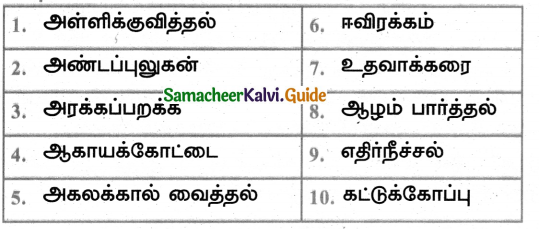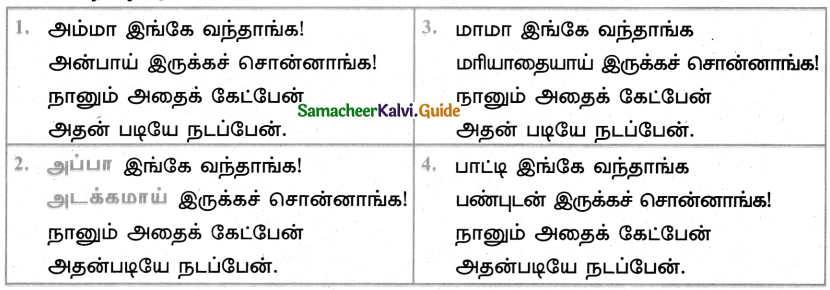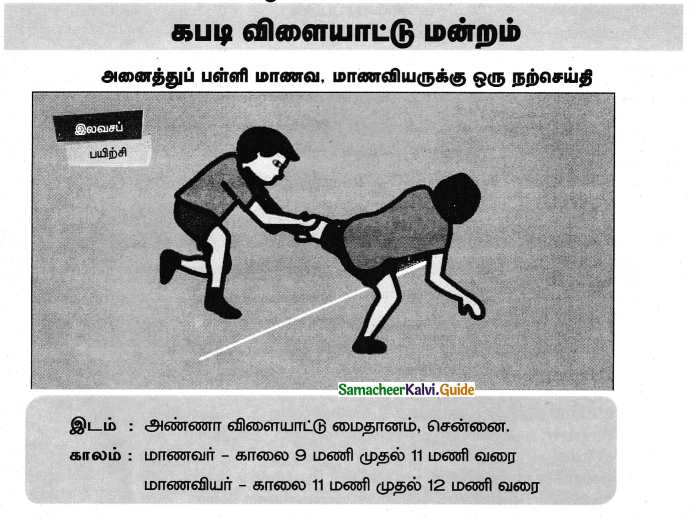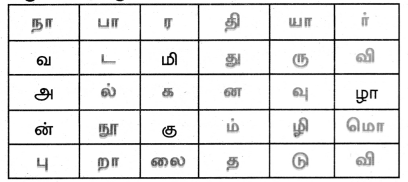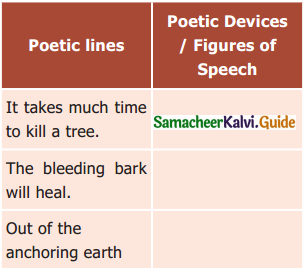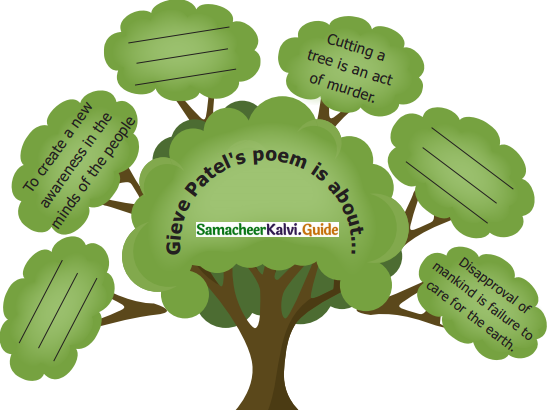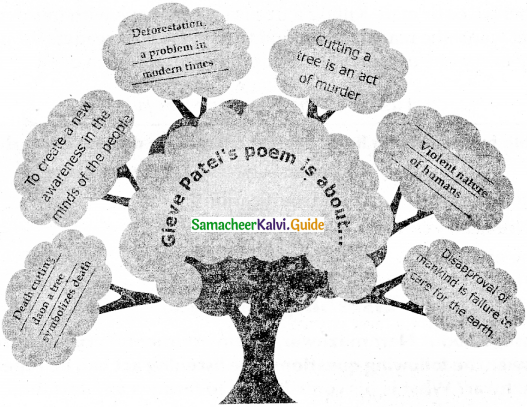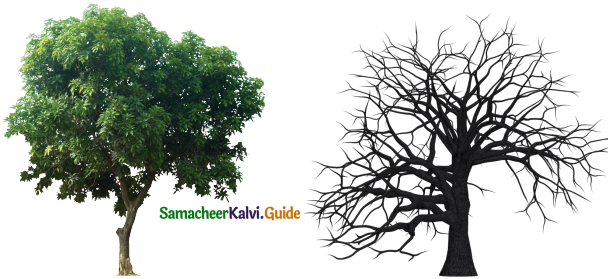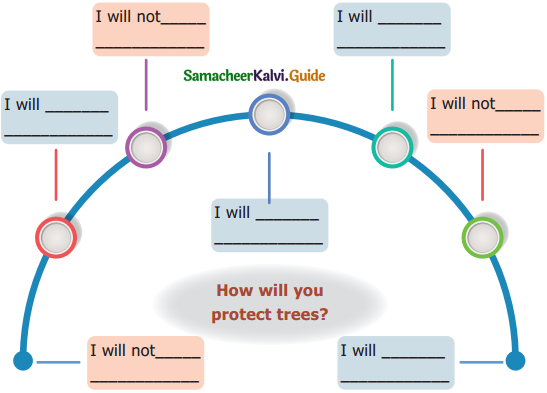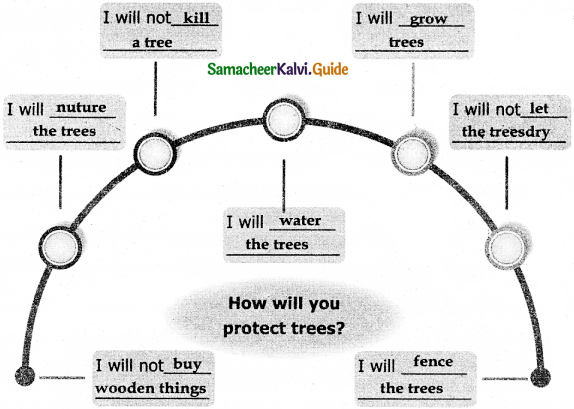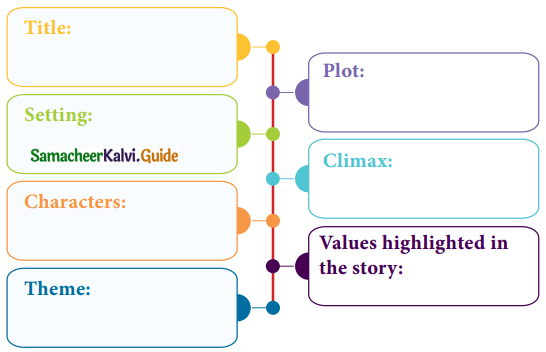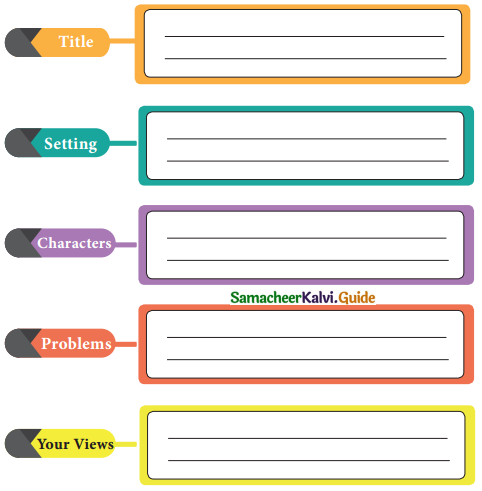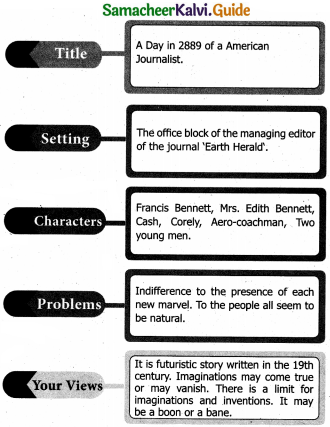Tamilnadu State Board New Syllabus Samacheer Kalvi 9th English Guide Pdf Poem 6 The Comet Questions and Answers, Summary, Notes.
Tamilnadu Samacheer Kalvi 9th English Solutions Poem 6 The Comet
9th English Guide The Comet Textbook Questions and Answers
B. Read the following lines and answer the questions.
1. Rampaging through the heavens
Never stopping day or night.
Question (a).
How does the comet travel?
Answer:
The comet travels through the sky, making a lot of noise and causing damage.
Question (b).
Which word could you replace ‘rampaging’ with?
Answer:
Speeding
2. Faster than a cheetah
with a tail that’s miles long.
Question (a).
Why is the comet compared to a cheetah?
Answer:
Comet is compared with the cheetah due to its speed.
Question (b).
Whose tail is compared here?
Answer:
The tail of the comet is compared here.
![]()
3. With shockwave reaching to the ground
causing the land to quake.
Question (a).
What is reaching the ground?
Answer:
The shockwave produced by the comet reaches the ground.
Question (b).
What is causing the land to quake?
Answer:
The shockwave is causing the land to quake.
4. In the dust they leave behind could have started life
on the earth which resulted in mankind
Question (a).
What does the word ‘they’ refer to?
Answer:
The word They’ refers to the comets.
Question (b).
According to scientists how did life start on earth?
Answer:
According to scientists, life started on the earth by the dust left behind by these comets.
![]()
5. But I know no better spectacle
Then a comet in full flight
Question (a).
Who does T ‘refer to?
Answer:
T refers to the poet.
Question (b).
What is the best spectacle mentioned in the above lines?
Answer:
The flight of the comet is the best spectacle mentioned in the above lines.
Additional Questions And Answers
1. A spectacle of a lifetime A comet is in full flight.
Question (a).
What is a spectacle?
Answer:
A spectacle is an unusual event that attracts attention and interest.
Question (b).
What is the spectacle of a lifetime?
Answer:
The flight of the comets is a spectacle of a lifetime.
Question (c).
What is in full flight?
Answer:
A comet is in full flight.
Question (d).
What is meant by ‘flight’?
Answer:
A flight is a journey made by flying.
![]()
2. Bigger than a mountain
So powerful and strong
Question (a).
What is bigger than a mountain?
Answer:
A comet is bigger than a mountain.
Question (b).
Which is so powerful and strong?
Answer:
The comet is so powerful and strong.
![]()
3. And leaves a trail behind
it As it travels on its course
Question (a).
What does ‘it’ refer to?
Answer:
‘It’ refers to the comet.
Question (b).
What does the comet leave behind it?
Answer:
The comet leaves a trail behind it.
Question (c).
What is a trail?
Answer:
A trail is a path made for a purpose.
Question (d).
Where does the comet travel?
Answer:
The comet travels on its course.
Question (e).
What is meant by “course” here?
Answer:
Here, course means “line of action’’.
![]()
4. The outer ice is melting
causing vapor from the force.
Question (a).
What is melting?
Answer:
The outer ice is melting.
Question (b).
What is outer ice?
Answer:
The ice that has covered the comet is the outer ice.
Question (c).
How is vapor caused?
Answer:
Vapour is caused by the force.
5. If one should come too close to
earth The atmosphere will shake
Question (a).
What does ‘one’ refer to?
Answer:
‘One’ refers to a comet.
![]()
Question (b).
What will happen if a comet comes too close to the earth?
Answer:
If a comet comes too close to the earth the atmosphere will shake.
Question (c).
What is meant by the atmosphere?
Answer:
The atmosphere is the mixture of gases surrounding the earth.
6. I cannot say if this is true
I do not have the right
Question (a).
Who is T?
Answer:
I is the poet.
Question (b).
What doubt does the poet raise here?
Answer:
The poet raises the doubt that he cannot say if all said about the comet is true or not.
![]()
Question (c).
What does he admit?
Answer:
He admits that he has no right.
Question (d).
What is meant by ‘right’?
Answer:
Right is something one may do or have by law.
C. Complete the summary by filling in the given space with suitable words phrases given below.
The poet describes a moving comet which speeds through the heavens and never takes a break by (1)………… or night. When a comet is in full flight, it gives a (2)…………. which can never be compared to anything else for a lifetime. The comet is compared to (5)………….. for its speed and a mountain as it is (3)………….. The (4)…………. melts which cause a vapour from the force and leaves behind (6)………… as it travels on its way. If it comes very close to the atmosphere, it causes a shake which in turn produces (7)…………. that reach the Earth’s surface. According to the (8)…………. the comets leave behind chemicals in the form of dust which resulted in the (9)……….. and mankind came into existence. But the poet is not sure whether this principle is true or not but he knows for sure that whatever the truth may be, the sight of the comet in full flight is the best (10)…………
Answer:
- day
- spectacular scene
- a cheetah
- powerful and strong
- outer ice
- a trail
- a shock wave
- scientist
- emerging of life on earth
- spectacular
![]()
D. Poem Appreciation
If one should come too close to the earth
The atmosphere will shake,
With shock wave reaching to the ground Causing the land to quake
Question 1.
Pick out the rhyming words.
Answer:
Shake and quake are rhyming words.
Question 2.
Mention the rhyme scheme of the stanza.
Answer:
The rhyme scheme is a b c b.
Question 3.
When you read the poem aloud, you can feel/hear a rhythm. What according to you gives rhythm to the poem- the rhymes or the words in a line. Support your answer with examples from the poem?
Answer:
When I read the poem aloud, I feel a musical rhythm and feel a regular pattern of sound. This is due to the number of syllables in lines 1 and 3 which is similar to the number of syllables in lines 2 and 4.
![]()
The consistency of(the verses in each stanza is well managed and controlled. The first and third lines do not rhyme at all. If we consider the poem stanza wise, the lines are metered uniformly. The rhyme scheme of each stanza is abcb. The poet has used simple language to make the readers to enjoy the poem meaningfully.
D. Answer the following questions in about 80 -100 words.
Question 1.
Narrate how the poet describes the comet.
Answer:
Title: The Comet (Poem)
Author: Norman Littleford (Poet)
Characters: Poet and Comet.
Theme: Comets are like libraries storing the record of our formation in tiny particles.
The poet Norman Littleford wonders at the beautiful spectacle of the comet in the sky. The comet is moving through the heavens at a great speed. It has never stopped day or night. When a comet is a complete flight, it gives a spectacular scene. The poet says that it can never be compared with anything else for a lifetime. He says that a comet runs faster than a cheetah.
To him, a comet is more powerful and stronger than a mountain. The outer ice melts causing a vapour from its force. As it travels on its way, it leaves behind a trail. If the comet comes very close to the atmosphere, it can cause a shake which in turn produces a shockwave that reaches the Earth’s surface.
![]()
The scientists are of the opinion that the comets leave behind chemicals in the form of dust that has resulted in the emerging of life on earth and thus the mankind has come into existence. But it is not very sure whether this concept is true or not. However, he knows for certain that whatever the truth may be, the appearance of the comet in full flight is the best spectacular in the sky.
“A comet is an incredible and incomparable spectacle ”.
(OR)
Norman Littleford describes a moving comet in his poem. It speeds through, the heavens never stopping day or night. In its full flight, the comet gives a spectacle and it has no comparison to anything else. It is compared to a cheetah for its speed. It is stronger and more powerful than a mountain.
The outer ice melts causing a vapour and leaving a trail as it travels. Coming close to the atmosphere it causes a shake with shock waves resulting from an earthquake. The scientists say that the comets leave behind chemicals as dust and it produced life on earth. But the poet is doubtful if it is true or not. However, he is certain that the comet in full flight is the best spectacular scene.
“A Comet is an incomparable spectacle.
![]()
Question 2.
Give a detailed account of various effects caused by the comet to the earth.
Answer:
Comets are cosmic snowballs of frozen gases, rock and dust that orbit the sun. The dust and gases form a tail that stretches away from the sun for millions of miles. The poet describes the comet that travels at a great speed. He says that it is faster than a cheetah and stronger as a mountain. He imagines that the comet is very large in size and it can shake the earth if it comes very close to it.
He thinks that the shake can cause shockwaves and it can result in an earthquake. The comets leave behind the chemicals in the form of dust. The poet says that life could have started then on the earth. He also affirms that it might have resulted in mankind. However, the poet is not very sure whether this is true or not. But he admires that there can be no better spectacle than a comet in full flight.
“Amidst all dangers, a comet is spectacular”.
(OR)
A comet is a ball of mostly ice that moves around in outer space. It travels at great speed on its way. The comet is big in size and very powerful and strong. If the comet comes very close to the earth, the atmosphere will shake. The shockwave reaches the ground.
It certainly causes the land to quake. The comet leaves behind the chemicals in the form of dust. Then life started on the earth. And it resulted in mankind. The poet is not sure if this is true or not. But he is confident that there is no better spectacular scene than a comet in full flight.
![]()
F. Listening
Listen to the passage on ‘Comet’ and fill in the blanks with the correct answer.
Question 1.
Comets are believed to be remnants of the materials created by the
(a) Moon
(b) Sun
(c) Star
(d) Asteroids
Answer:
(b) Sun
Question 2.
Comets are mostly made of
(a) dust
(b) ice
(c) sand
(d) snow
Answer:
(b) ice
Question 3.
The can be seen in the night sky as bright, quickly-moving light.
(a) head
(b) star
(c) tail
(d) wings
Answer:
(c) tail
![]()
Question 4.
Comets orbit at the very edge of the galaxy, past the
(a) Earth
(b) Neptune
(c) Pluto
(d) Saturn
Answer:
(c) pluto
Question 5.
State whether the statement is true or false.
The melting process causes bits of dust and debris to trail behind the comet.
Answer:
True
G. Speaking
Imagine you are interviewing an astronaut about his/her experiences in space. Select a partner to be an astronaut and present the interview as a role-play in front of the class.
“Interviewing an astronaut”
You: We are lucky to welcome you, sir. I would like to ask you a few questions.
Astronaut: Thank you. It’ll be my pleasure to answer your questions.
You: What is the view like from space?
Astronaut: The first time you look out the window once you’re in space, I think the reaction of every astronaut is the same; first there’s a huge gap. It goes ‘AW, Vow!’ You just can’t believe what you’re looking at. I was amazed at the blackness of space. It was a darker, richer colour than I had ever seen before.
You: What are the best views of Earth from space?
Astronaut: I always loved passing over Egypt. To see the Nile River the bright green
pathway cutting through the centre of Egypt was just spectacular.
You see the blue water of the Mediterra nean and the brown desert areas.
This contrast between, green and bright blue was just breathtaking and, because I had been there on Earth, it was extra special for me to see from space.
You: What’s the in-flight food and entertainment like on a spacecraft?
Astronaut: The food is not good, but it is not horrible. I think the most popular
entertainment for astronauts is looking out the window. I love sitting near the window and just watching the Earth go by.
You: Do you think space is the future of travel?
Astronaut: Space tourism is definitely coming and we’re very close to it. I think there’s going to be a long line of people who want to get in on that. The more people that can get up to space to look back at planet Earth, I think the better off we’re all going to be. I wanted everybody to see the perspective that I just had.
![]()
Writing
H. Imagine that you and your friend get a chance to visit another planet there you befriend an alien who takes you around the planet. After reaching the earth, write a letter thanking him for all the help he did.
Answer:
| Dear alien, We landed on the earth safely. It was an amazing experience to travel in space. My friend and 1 were very fortunate to be a friend of yours on the strange planet. We felt at home after meeting on the new planet. But for your help, we could not have made our visit a success. We are very thankful to you for your friendship and entertainment. We have enough confidence to make another visit there as you are there to host us. We are heartened to feel that we are not alone in the universe. We are sure that you are friendly beings, as we have observed you all. We invite you to visit us. Please come and live among us and share your wisdom with us. We do really need it. If you come to earth, I am sure that you would like it. On behalf of all humanity, I welcome you to Earth. Looking forward to your early arrival.
Yours Sincerely, |
![]()
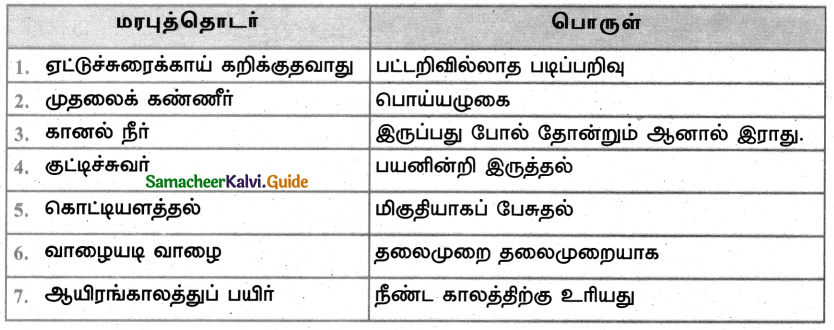 Question 2.
Question 2.